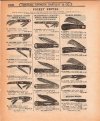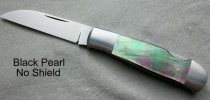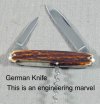Looking through hundreds of knives in doing my research for patterns, I've noticed a few things that might add to the conversation:
1. Whatever kind of shield you could imagine, can, and may already have been done on a knife. There are an infinite variety of shields with new ones being used all the time.
2. Early on, shields were omitted from a wide variety of knives. In looking through the books, handles like stag and stag-bone, and even some jigged bone, were not made with shields. Probably due to the texture and the beauty of the handle material.
I think some shields were omitted in some cases because the knives were being made for, and sold to, a wide variety of people. Looking at old ads from the 1880-1945, you see lots of knives without shields and the same knives in different ads. It may have been a cost factor back in the day when everything was done by hand. I have also noticed that many German made knives had no shields. Can't say as I know why or why not. Maybe shields are more American in nature. Any historians out there that can offer an opinion??
The "meaning" for some makers was brand recognition. If you saw a particular shield, you automatically knew who made the knife. No need to look at the tang stamp, you could tell by the shield.
The meaning for some was nothing more than ornamenting a bland or inexpensive handle material to make the knife look better and sell for a bit more.
The meaning now, for many, is tradition or the love affair someone has with a traditional pattern, manufacturer or maker.
Some manufacturers now use no shield because of the delicacy or texture of the handle material. This would apply to materials like black pearl, gold pearl or mammoth ivory which are becoming more difficult to obtain and already have enough appeal without the shield.
And some use the shields to express originality and their artistic flair, as in the gold shields and interesting shapes you see in the custom makers' knives today.
3. Value is subjective. In traditional, collectible knives, the shields are important because of the history of the manufacturer or maker. For makers today, the shield, or lack of one, may be their new history and tradition that users come to expect and appreciate. I have seen some old knives that are true masterpieces of engineering and they are valued for that quality alone. Some knives scream for a shield. Some obviously don't need one. The value is in your eyes, or the eyes of the user.
It's completely up to you. After all, and I say this almost every day, knives are like cars and girls, it's a love affair. It's all in the eyes of the beholder. I think that might be one of the things that makes knife using and collecting so much fun and so popular.
Thanks for reading my rants. Thanks for the opportunity to throw my two cents in!!
Keep Care,
Pappy




